Role of Medicinal plant-derived Nutraceuticals as a potential target for the treatment of breast cancer
[Corrections added on 1 December 2022, after first online publication. CAUL. funding statement was added].
Abstract
Breast cancer (BC) is one of the most challenging cancers to treat, accounting for many cancer-related deaths. Over some years, chemotherapy, hormone treatment, radiation, and surgeries have been used to treat cancer. Unfortunately, these treatment options are unsuccessful due to crucial adverse reactions and multidrug tolerance/resistance. Although it is clear that substances in the nutraceuticals category have a lot of anti-cancer activity, using a supplementary therapy strategy, in this case, could be very beneficial. Nutraceuticals are therapeutic agents, which are nutrients that have drug-like characteristics and can be used to treat diseases. Plant nutraceuticals categorized into polyphenols, terpenoids, vitamins, alkaloids, and flavonoids are part of health food products, that have great potential for combating BC. Nutraceuticals can reduce BC's severity, limit malignant cell growth, and modify cancer-related mechanisms. Nutraceuticals acting by attenuating Hedgehog, Nuclear factor kappa-light-chain-enhancer of activated B cells (NF-κB), Notch, and Wnt/β-catenin signaling are the main pathways in controlling the self-renewal of breast cancer stem cells (BCSCs). This article reviews some important nutraceuticals and their modes of action, which can be very powerful versus BC.
Practical applications
Nutraceuticals' importance to the control and diagnosis of breast cancer is undeniable and cannot be overlooked. Natural dietary compounds have a wide range of uses and have been used in traditional medicine. In addition, these natural chemicals can enhance the effectiveness of other traditional medicines. They may also be used as a treatment process independently because of their capacity to affect several cancer pathways. This study highlights a variety of natural chemicals, and their mechanisms of action, routes, synergistic effects, and future potentials are all examined.
Abbreviations
-
- ADAM
-
- A-disintegrin&metalloproteinase
-
- ALDH
-
- aldehyde dehydrogenase
-
- ALDH1A3
-
- aldehyde dehydrogenase-1A3
-
- BC
-
- Breast cancer
-
- BCL2
-
- B-cell lymphoma 2
-
- BCSCs
-
- Breast cancer stem cells
-
- BNIP3
-
- BCL2 interacting protein 3
-
- CAF-CM
-
- cancer-associated fibroblasts -conditioned media
-
- CCND1
-
- Cyclin D1
-
- EGFR
-
- epidermal growth factor receptor
-
- EMT
-
- epithelial–mesenchymal transition
-
- ER
-
- estrogen receptor
-
- GADD45A
-
- growth arrest and DNA damage-inducible 45 alpha protein
-
- Gli1
-
- GLI family zinc finger 1
-
- GSK3
-
- Glycogen synthase kinase 3
-
- GSK-3β
-
- glycogen synthase kinase-3 beta
-
- IL-8
-
- Interleukin-8
-
- JNKs
-
- c-Jun N-terminal kinases
-
- MAM
-
- Mastermind
-
- MMP-9
-
- Matrix metallopeptidase 9
-
- mTOR
-
- mammalian target of rapamycin
-
- NF-κB
-
- Nuclear factor kappa-light-chain-enhancer of activated B cells
-
- NICD
-
- Notch intracellular domain
-
- NOB
-
- Nobiletin
-
- NQO1
-
- NAD(P)H:quinone oxidoreductase 1
-
- Nrf2
-
- nuclear factor erythroid 2–related factor 2
-
- PI3K
-
- phosphatidylinositol-3-kinase
-
- PKCα
-
- Protein kinase C alpha
-
- PPARγ
-
- Peroxisome proliferators–activated receptor γ
-
- PRKD1
-
- Protein kinase D1
-
- SMO
-
- smoothened
-
- STAT3
-
- Signal transducer and activator of transcription 3
-
- TAZ
-
- Transcriptional-co-activator-with-PDZ-binding motif
-
- TNFRSF9
-
- tumor necrosis factor receptor superfamily 9
-
- TPA
-
- 12-O-tetradecanoylphorbol-13-acetate
-
- TRHDE-AS1
-
- TRHDE-antisense-RNA-1
-
- VEGF
-
- Vascular endothelial growth factor
1 INTRODUCTION
One of the most common cancers is breast cancer, a leading cause of cancer-related mortality among women globally BC throws millions of women's lives into disarray (Abdel-Salam et al., 2019; Baraya et al., 2017). In 2021, it was estimated that 2.1 million new BC cases would be diagnosed worldwide. This number will likely exceed a quarter million in the United States alone. BC has continuously been rated among the top malignancies in women for many years, both in incidence and death. On the other hand, men's mortality rates increased dramatically in 2018 compared to women's (9.09% in men, compared to 1.87% in women; Chen et al., 2021; Chowjarean & Sadabpod, 2021; Chellappan et al., 2017). Genetic susceptibility, environmental factors, and lifestyle all contribute to cancer. For example, the density of breasts and age are natural factors that can enhance the risk of BC. In addition, changes in circadian rhythm, alcohol intake, and tobacco chewing or smoking are known to increase the risk of BC. These conditions can lead to cellular stress, increased generation of free radical oxygen species, and alterations in progesterone and estrogen hormone, which expand tumor aggression (Churiyah et al., 2020). Chemotherapy, radiation, and surgery are common treatments for BC, but they have a poor prognosis and long-term adverse effects. As with other malignancies, BC therapy is hampered by metastasis, recurrence, and medication resistance (Alharbi et al., 2022; Colamba Pathiranage et al., 2021). To overcome the problem associated with BC treatment, scientists focus on nutraceuticals as an emerging therapy with fewer side effects. Nutraceuticals also act as an adjuvant therapy with currently available chemotherapeutic drugs as these nutraceuticals can reduce drug-associated side effects and resistance phenomena (Collard et al., 2020; Gupta, Al-Malki, et al., 2021). People have employed natural medicines derived from various plants or nonherbal sources to cure various diseases since ancient times, with many promising outcomes. As science and technology evolve, there is an increasing demand for producing various herbal and nonherbal medications with therapeutic potential. As a result, there is much room for novel nutrition substrates that are good for human health. In 2017, around 79 billion US dollars market for nutraceuticals was assumed to rise to 734 billion US dollars by 2026 worldwide (Dandawate et al., 2016; Dhouibi et al., 2020).
Nutraceuticals are therapeutic agents that show drug properties and can treat life-threatening diseases such as diabetes, atherosclerosis, cancer, neurodegenerative diseases, and hematological disorders. According to the research results, polyphenols, terpenoids, tannins, alkaloids, and flavonoids are part of health food products, that have great potential to fight these life-threatening diseases (Espinosa-Paredes et al., 2021; George et al., 2021; Gupta, Kazmi, et al., 2021). Certain crucial and relevant processes associated with BC are emphasized in this review, and nutraceuticals and their processes and potentiality to combat BC are reviewed.
2 PATHOPHYSIOLOGY OF BREAST CANCER
BC usually begins with hyperplasia of the ducts and then develops into benign tumors and even metastatic cancer as various carcinogens stimulate them. In the development of BC and its progression, the microenvironment of tumors such as macrophages and the influence of stroma play a crucial role. Macrophages can produce a mutagenic inflammation microenvironment that boosts angiogenesis and allows carcinogenic cells to escape through the immune system's rejection (Graidist et al., 2015). The stochastic and cancer stem cell theories are two possible explanations for BC's beginning and development. According to the stochastic hypothesis, each tumor subtype develops from a single cell type, differentiated progenitor, or stem cell. Random mutations can accumulate over time in any breast cell, eventually transforming it into a tumor cell when enough mutations have been collected. According to the cancer stem cell theory, all tumor subtypes are generated from identical progenitor cells or stem cells. Different tumor phenotypes will result from acquired epigenetic and genetic alterations in progenitor cells or stem cells (Figure 1; Guerra et al., 2021).
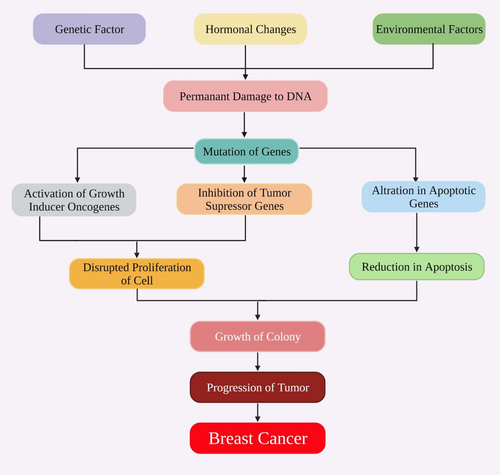
3 SIGNALING PATHWAYS IN PATHOGENESIS OF BC
There is a striking resemblance between normal and cancer growth at the molecular level. During normal human development, the complex signaling pathways are tightly controlled, allowing cells to interact with each other and their environment. Cancer cells and BC stem cells (BCSCs) will destroy or occupy many of these similar signaling pathways. Differentiation and self-renewal are two characteristics shared by BCSCS and other stem cells. BCSCs can divide and create duplicate daughter cells through asymmetric or symmetric cell division. Hedgehog, NF-κB, Notch, and Wnt/β-catenin signaling are the main pathways in controlling the self-renewal of BCSC (Hu et al., 2019; Ismail et al., 2021).
3.1 Wnt/β-catenin signaling
The Wnt/β-catenin signaling system, which is highly conserved, is essential for cell proliferation and differentiation. However, this system is frequently unregulated and abnormally active during carcinogenesis, promoting clonal growth. This abnormal signaling promotes BCSC's self-renewal and related characteristics (metastasis, resistance to multiple drugs, invasiveness; Jabeen et al., 2020). The involvement of Wnt signaling in BCSC is associated with the preservation of stem cell characteristics: inhibition of WNT1 alters the phenotype of CD44+CD24−ALDH1−, reducing tumor growth and cell migration in vivo as well as in vitro (Jaglanian & Tsiani, 2020). According to the findings of Xin Sun et al., Let-7 can block Wnt/β-catenin to make BCSCs more sensitive to tamoxifen, leading to reduced self-renewal and oncogenicity (Jiang et al., 2013). The inhibitory action of protein kinase D1 (PRKD1) was adequate to diminish the stemness properties of BC cells by suppressing glycogen synthase kinase 3 (GSK3)/−catenin signalling (Karia et al., 2018). Blocking the Wnt/β-catenin signaling by cutting down miR-142, a prominent effector for activating this signaling, reduced BCSC tumor-initiating potential and mammosphere development, according to TaichiIsobe et al. miRNAs have been linked to various oncogenic events, including BC carcinogenesis via the canonical Wnt pathway modulation. In individuals with BC, abnormal activation of Wnt/β-catenin signaling has been linked to tumor development and poor prognosis (Figure 2; Khazaei & Pazhouhi, 2019).
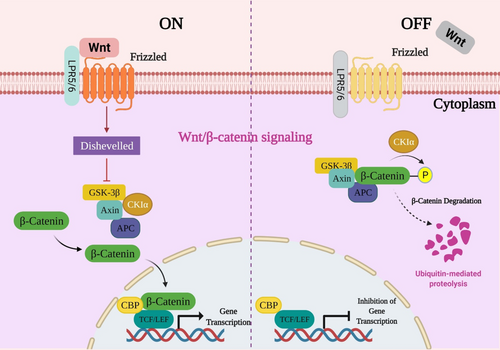
3.2 Hedgehog signaling
During embryonic development, hedgehog (Hh) signaling is essential for morphogenesis. However, dysfunction of this pathway is associated with carcinogenesis, and abnormal and hyperactive signal transduction is found in about a quarter of human malignancies, including BC (Kushwaha et al., 2020). Evidence suggests an essential role for the Hh pathway in BC, such as Hh overexpression or PTCH1 polymorphism, which leads to SMO activation and stimulation of hedgehog signaling. In addition, these changes are associated with more aggressive phenotypes, such as BC of triple-negative type. Hh signaling is required for the BCSC phenotype to be maintained and self-renewal regulated (Kwon et al., 2021). In comparison to MCF-7 cells cultivated as monolayers, MCF-7 mammospheres exhibited higher amounts of Hh pathway members. They also discovered a link between the expression of smoothened (SMO)/GLI family zinc finger 1 (Gli1) and the BCSC markers CD44+CD24− in BCSCs (Li, Wang, & Xiao, 2021; Sharma et al., 2021). Through a p21-mediated suppression of Hh-Gli signaling, resveratrol and curcumin work together to trigger apoptosis in cigarette smoke condensate-altered breast epithelial cells (Li, Zhou, et al., 2021). By boosting Smoothened degradation in a proteasome-dependent manner, wogonoside suppresses Gli1 nuclear translocation and transcriptional activity linked with Hedgehog signaling, resulting in BC of Triple-Negative type angiogenesis suppression (Figure 3; Lin et al., 2018).
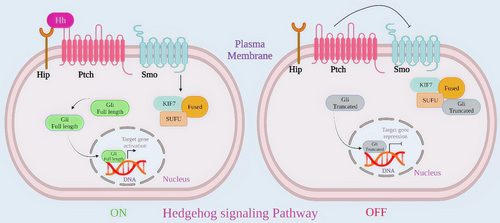
3.3 NF-κB pathway
The activation of NF-κB has been shown in various cancers, including BC. Constitutive activation of NF-κB in BCs leads to cellular proliferation, evasion of apoptosis, and angiogenesis. It is most commonly seen in human epidermal growth factor receptor 2 and triple-negative cancers (Lopes et al., 2017). In BC cells that efficiently produce tumorspheres, NF-κB was activated. In addition, standard and nonstandard NF-κB signaling is required for these cells to self-regenerate in vitro and efficiently form xenograft tumors in vivo (de Souza et al., 2018; Mahmoodi et al., 2022). The transition of rat mammary cancer from a non-malignant, estrogen receptor (ER)-positive phenotype to a malignant, ER-negative phenotype was accompanied by a constitutive increase of NF-κB signaling. In the context of cancer stem cells, NF-κB signaling is essential for creating secondary mammospheres in CD44+ murine cells, and it appears to be a crucial factor in therapy resistance (Aggarwal et al., 2020; Majumder et al., 2021; Mansoori et al., 2017). Melatonin was found to lower both gene and protein expression of NF-κB in BC cells, according to Jucimara Colombo et al. These findings revealed that, depending on the cell type, NF-κB plays a dual role in its expression (Marvibaigi et al., 2014; Shaikh et al., 2022). One of the critical pathways in which NF-κB is involved in the resistance of cancer cells to treatment is the production of anti-apoptotic proteins. The endogenous and extrinsic apoptotic pathways are linked by the induction of NF-κB-regulated IAP and BCL-2 family members. Survivin is an NF-κB regulatory protein that is overexpressed in various human malignancies and is considered a marker of treatment resistance and a therapeutic target in cancer treatment (Lu et al., 2019; Mohd Fisall et al., 2021).
3.4 Notch signaling
The Notch signal is involved in cell proliferation and differentiation and is essential for the development and growth of human organs. Signaling is often overactive in tumors and is linked to BCSC self-renewal (Mughees & Wajid, 2021). Notch signaling is primarily triggered via cell-to-cell interaction, activated when Notch receptors on the receiving cell's surface contact Delta or Jagged proteins on the transmitting cell's surface. Jagged/Delta-Notch interplay stimulates Notch intracellular domain (NICD) release, bisected by enzymatic complex γ-secretase and A-disintegrin&metalloproteinase (ADAM) proteases. NICD enters the nucleus after cleavage, where it interacts with the co-activators p300 and Mastermind (MAM) to control the target genes of Notch (Nallanthighal et al., 2017; Nassan et al., 2018). The function of the Notch pathway in the BCSC's ability to self-renew has been verified, and BC cells with high Notch activity have been identified by Rosemarie C D'Angelo et al. Significantly overexpressed cancer stem cell markers increased both in vitro and in vivo tumor-forming ability (Nguyen et al., 2019). Aldehyde dehydrogenase (ALDH)-positive BCSCs have a significant amount of Notch-1, a Notch signaling receptor that stimulates epithelial-mesenchymal transition (EMT). When Psoralidin represses Notch-1, however, the stimulating impact is inhibited (Phan et al., 2020).
3.5 Autophagy
In all phases of cancer progression, autophagy plays a vital role. Recent research has shown that autophagy is a ‘two-edged sword’; it inhibits malignant development. In the early stages of cancer, it reduces chromatin instability, tissue damage, and inflammation mostly related to cancer growth (Arun et al., 2015; Chong et al., 2021). Autophagy may perform a complicated role throughout later phases depending on internal and external circumstances. Proliferation is a characteristic hallmark of cancer, which may encourage metastasis and result in food insufficiency (Chung et al., 2017; Kapinova et al., 2018). By sustaining and expanding cell viability, autophagy tends to stimulate the metastatic process, and If cells cannot establish stable contact with the extracellular matrix in their new environment, they enter a dormant condition (Cocco et al., 2020). However, in carcinoma cells that have undergone a complete transformation, the absence of autophagy may accelerate malignant tumor spread and neoplasia. Furthermore, it may increase breast cancer development independently of genotoxic stress and genomic instability (Han et al., 2018). Kongara et al. found a correlation between reduced Beclin1 expression and phosphorus (Ser73) buildup in human breast cancer. When cancer cells are exposed to metabolic and genotoxic stress as a result of progression and metastasis, and when therapy is accepted, autophagy transforms into tumor-promoting activities by maintaining the survival of tumor cells. Hypoxia and acidic chemicals may induce metabolic pressure, while chemotherapy and radiation may induce genotoxic pressure (Dell'Acqua et al., 2020; Li, Jin, & Li, 2021; Marsh & Debnath, 2020). Autophagy may decrease sensitivity to anti-cancer medicines, diminish organelle damage and DNA fragmentation, and preserve cellular integrity. Based on these results, inhibiting autophagy may increase the susceptibility of cancer cells to anti-cancer drugs (Niklaus et al., 2021).
In animals with a deficiency in autophagy, damaged mitochondria and protein complexes, including p62 and ubiquitinated proteins, accumulate, resulting in elevated ROS generation, DNA mutation, and chromatin condensation. Since genetic damage might increase the likelihood of tumor formation, the gene protection process governed by autophagy is expected to limit tumor growth (Ostendorf & Tavazoie, 2020; Sisinni et al., 2019). Under continual stimulation, tumor cells with autophagy defects often fail to maintain their life mechanisms, resulting in protracted death. Chronic cell death induces an inflammatory response that may increase the progression of cancer. Necrosis and inflammation may be induced by autophagy malfunction via the release of pro-inflammatory chemicals. HMGB1, generated by necrotic cells, interacts with RAGE on the cell surface, which may activate transcription factor NF-kB and trigger inflammation (Song et al., 2019; Tyutyunyk-Massey & Gewirtz, 2020).
Similarly, nucleic acids released from necrotic cells activate Toll-like receptors, stimulating the inflammatory response. Moreover, excessive autophagy may result in autophagic death. Under chronic stress and increasing autophagy, self-consumption causes cell death due to the elevated expression of Beclin1 and the formation of voluminous autophagosomes (Ulasov et al., 2019; Wang et al., 2020; Wang, Xie, et al., 2019).
4 NUTRACEUTICALS COMBATING BC
Nutraceuticals obtained from a range of sources may have the ability to trigger several physiological pathways that are advantageous to BC patients.
4.1 Polyphenols for the treatment of breast cancer
Polyphenols are compounds that include phenolic groups in their molecular structure and are extensively distributed in nature. Polyphenols are a necessary component of the human diet. For thousands of years, it has been utilized in traditional medicine worldwide. The effects of polyphenols are usually multifaceted. Many of these compounds have anti-cancer effects manifested by transformation, differentiation, growth, invasive inhibition of cancer cells, inhibition of angiogenesis, and induction of apoptosis (Putra et al., 2020; Raman et al., 2018; Rezadoost et al., 2019). Here we have to discuss polyphenol nutraceuticals and how they combat BC (Table 1). Curcumin commonly uses spice polyphenolic compounds obtained from the rhizome of Curcuma longa. Curcumin is a miracle chemical with high medicinal value in the Ayurvedic therapeutic system. Curcumin therapy caused apoptosis and reduced epidermal growth factor receptor Egfrinitiation and downstream signaling pathways in MDA-MB-231 BC cells (Sun et al., 2012). Curcumin suppresses the production of 12-O-tetradecanoylphorbol-13-acetate (TPA)-induced matrix metallopeptidase 9 (MMP-9) and cell invasion by reducing NF-κB and AP-1 activation. According to Jeong-Mi Kim et al., curcumin also prevented TPA-induced protein kinase C alpha (PKCα) transit to the membrane from the cytosol and reduced TPA-induced activation of p38 and c-Jun N-terminal kinases (JNKs; Kim et al., 2012). Curcumin inhibited the expression of proteins involved in EMT, including β-catenin, Fibronectin, Slug, N-cadherin, E-cadherin, Vimentin, AXL, and Twist1. In BC, curcumin also reduced migratory and invasive capacities (Gallardo & Calaf, 2016). Resveratrol (trans-3,4,5-trihydroxystilbene) is a polyphenolic phytoalexin obtained from Vitis vinifera. Many health advantages of resveratrol have been found for the neurological, cardiovascular, coronary, and hepatic systems. In vivo models of platelet aggregation, oxidative stress, viral infections, inflammation, and cancer cell development have been suppressed. BCSCs reduced the percentage of ALDH cells in MCF-7 and SUM159 cell lines and xenograft BCs. Resveratrol also prevented the tumorigenicity and the development of mammospheres of BCSCs while promoting autophagy primarily by inhibiting the Wnt β -catenin pathway (Fu et al., 2014). Human BC cells treated with cancer-associated fibroblasts-conditioned media (CAF-CM) were reduced in their growth, migration, and infiltration by resveratrol. Resveratrol administration decreased the CAF-CM-induced expression of MMP-9, MMP-2, c-Myc, and Cyclin D1was dropped by resveratrol administration. Furthermore, resveratrol reduced Sox2 expression and the activation of STAT3 and Akt in BC cells stimulated by CAF-CM (Suh et al., 2018). A natural phenolic compound obtained from cinnamon and clove is eugenol. Because it is a mild anesthetic, it is used by dentists as an analgesic and cement filling in the cavity. Eugenol has anti- anti-inflammatory and oxidant properties but also anti-cancer properties. Eugenol inhibits NF-κB signaling, which reduces the production of interleukin-8 (IL-8) and IL-6 and proves to be a therapeutic target via BCSCs suppression, which might restrict tumor development, dissemination, and incidence after therapy (Islam et al., 2018). Oleuropein is a phenolic molecule high in antioxidants and anti-cancer properties isolated from olives used to treat microbial infection, Inflammation, and viral infection (Bayat et al., 2019). Oleuropein suppresses tumor development and metastases spreading in ovariectomized nude mice bearing MCF-7 human breast tumor xenografts, according to Sepporta et al. (2014). Gossypiumhirsutum L. that is Cotton seeds contain the polyphenol compound gossypol, which is a minor ingredient. In China, gossypol has been used to treat viral diseases, malaria, and as a male contraceptive. In MM468 and MM231 cells, gossypol dramatically increased the expression of BCL2 interacting protein 3 (BNIP3), tumor necrosis factor receptor superfamily 9 (TNFRSF9), and growth arrest and DNA damage-inducible 45 alpha protein (GADD45A; Messeha et al., 2019). Protocatechualdehyde is a polyphenol chemical found in the root of the herb Salvia miltiorrhiza and the leaves of barley tea plants. In human colorectal cancer cells, protocatechualdehyde has proapoptotic and anti-proliferative characteristics. Through NF-κB and glycogen synthase kinase-3 beta (GSK-3β) -mediated proteasomal degradation, protocatechualdehyde suppresses β-catenin expression. Protocatechualdehyde also reduced cyclin D1 expression by proteasomal degradation, independent of β-catenin (Choi et al., 2014). Pterostilbene is a natural food polyphenol isolated from Cyanococcus. It has the same structure and biological activity as resveratrol but has a long half-life and excellent oral bioavailability (McCormack & McFadden, 2013). Pterostilbene treatment decreased cell proliferation, according to Wakimoto et al. (2017), with triple-negative MDA-MB-468 cells displaying the most growth inhibition. Pterostilbene inhibited mTOR and AKT phosphorylation, followed by overexpression of BAX without impacting BCL-xL, and generated significant and prolonged ERK 1/2 activation and cyclin D1 suppression (Table 1).
| Compound | Chemical structure | Biological Source | Mechanism, breast cancer cell lines and doses | Ref |
|---|---|---|---|---|
| Curcumin |

|
Curcuma longa | Suppression of EGFR expression and activation Induction of apoptosis. (Cell lines: MDA-MB-231 cells and Dose: 10, 20 and 30 μmoL/ml) | (Sun et al., 2012) |
| Inhibition of NF-κB/AP-1 and MAPK, and PKCα signaling, expression of MMP-9 induced by TPA. (Cell lines:MCF-7; Dose:1, 5, 10, 30 and50 M) | (Kim et al., 2012) | |||
| Down regulation of expression of β-catenin, Fibronectin, Slug, N-cadherin, E-cadherin, Vimentin, AXL, and Twist1 protein which are part of EMT. (Cell lines: MCF-10F, Tumor2 and MDA-MB-231; Dose:30 μM) | (Gallardo & Calaf, 2016) | |||
| Resveratrol |
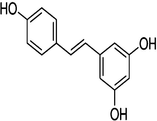
|
Vitis vinifera | By inhibiting the Wnt β -catenin pathway. (Cell lines: MCF10A, MCF-7 and SUM159; Dose:100 mg/kg/d) | (Fu et al., 2014) |
| Reduction in expression of MMP-9, MMP-2, c-Myc, and Cyclin D1; Decline Sox2 expression as well as the activation of STAT3 and Akt. (Cell lines: MCF-7 and MDA-MB-231; Dose:10, 25, and 50 μM) | (Suh et al., 2018) | |||
| Eugenol |
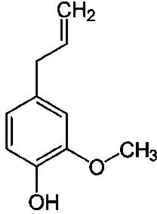
|
Syzygium aromaticum | Inhibits NF-κB signalling, which reduces the production of IL-8 and IL-6. (Cell lines: MDA-MB-231, MDA-MB-468 and BT-20; Dose: 0.25, 0.50, 0.75, 1.0 and 1.5 μM) | (Islam et al., 2018) |
| Oleuropein |
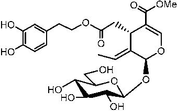
|
Olea europaea | Inhibiting both MCF-7 cell xenograft development. (Cell lines: MCF-7; Dose: 1.7 mg/day) | (Sepporta et al., 2014) |
| Gossypol |
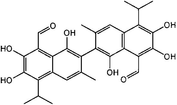
|
Gossypium hirsutum | Increases the expression of BNIP3, TNFRSF9, and GADD45A. (Cell lines: MDA-MB-231 (MM-231) and MDA-MB-468 (MM-468); Dose: 0–100 μM in MM-231 cells and 0–50 μM in MM-468 cells) | (Messeha et al., 2019) |
| Protocatechu aldehyde |

|
Salvia miltiorrhiza | Suppresses β-catenin and cyclin D1 expression. (Cell lines:MCF-7 and MDA-MB-231; Dose: 0, 5, 10, 25, 50, or 100 lM) | (Choi et al., 2014) |
| Pterostilbene |
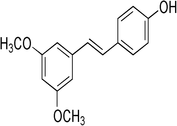
|
Cyanococcus | Inhibits mTOR and AKT phosphorylation, Suppress cyclin D1 expression. (Cell lines: MDA-MB-468 cells; Dose:50 μM | (Wakimoto et al., 2017) |
4.2 Flavonoids for the treatment of breast cancer
Flavonoid is a natural chemical with a high nutritional value and promise for illness therapy. Flavonoids, the most prevalent polyphenols in the human diet, are found in fruits, vegetables, and vegetable beverages and are key components of many herbal products. Flavonoids have been shown to increase the expression of tumor suppressor genes, which may help reduce cancer development and metastasis in various cancers (Selvakumar et al., 2020). Citrus depressa Hayata, a common citrus fruit, yields nobiletin, a poly-ethoxy flavone. Nobiletin (NOB) has various beneficial effects, such as cardiovascular protection, anti-tumor, immune regulation, combating chronic inflammation and oxidative stress, preventing resistance to insulin, anti-osteoclastogenesis, and neuroprotection (Li et al., 2018). According to the findings, nobiletin suppressed ERK1/2 activity, led to stoppage of the cell cycle during the G0/G1 phase, and inhibited cyclin-D1 and over-expression of p21. In MDA-MB-468 cells, nobiletin decreased the activities of mTOR and AKT and triggered apoptotic cell death by lowering Bcl-xL expression without changing Bax levels (Noguchi et al., 2016). Baicalin is a flavonoid extracted from the dried root of Scutellariabaicalensis Georgi, which is used to treat CNS illnesses, liver illnesses, and inflammatory problems, among other things. In vivo and in vitro, baicalin decreased NF-κB-p65 protein production, resulting in reduced expression of B-cell lymphoma 2 (BCL2), BIRC3, BIRC2, and cyclin D1 (CCND1), which leads to a reduction in cell proliferation, infiltration, and migration while reducing antiapoptotic factors as well as causing cell cycle disruption in the G1/S phase (Gao et al., 2018). Ellagic acid, flavonoid polyphenols rich in pomegranates, strawberries, walnuts, and muscadine grapes suppress cancer cells' growth and causes apoptosis. In vitro, the TGF-β/Smads signaling pathway is a putative molecular mechanism through which EA regulates the BC cell cycle shunt (Chen et al., 2015). Eupatorium bioactive constituents are part of flavonoids, which may be found in various fruits, vegetables, and plants. Eupatorium exerted a time-dependent suppression of proliferative activity in sub-G0/G1 by disrupting the MCF-7 and MDA-MB-231 cell cycles. Eupatorin regulates apoptosis-promoting genes such as SMAC/Diablo, cytochrome c, Bax, Bak1, Bad, and HIF1A, blocking the p-Akt pathway (Abd Razak et al., 2019). Genistein, a natural phytoestrogen isoflavone in soybeans, has various anti-cancer activities. Furthermore, genistein has been shown to reduce the resistance to cancer medications and prevent relapse/recurrence of cancer. Genistein decreased the development and proliferation of MCF-7 BC cells while promoting apoptosis. Genistein suppressed BC stem-like cells and lowered BCSCs via downregulating the Hedgehog-Gli1 Signaling (Chen & Chien, 2019). In TNBC patients and ER-negative, the BRCA2 and BRCA1 genes are altered or epigenetically silenced. BRCA2 and BRCA1 promoter methylation is reduced by genistein, resulting in increased BRCA2 and BRCA1 protein levels in BC cell lines (Bosviel et al., 2012). Kaempferol, derived from the miracle tree Moringaoleifera, is one of the most prevalent dietary flavonols. In MDA-MB-453 cells of human BC, kaempferol stops the cell cycle in the G2/M stage by inhibiting CDK1 (Akram et al., 2017). According to researchers, kaempferol is a potent nuclear factor erythroid 2–related factor 2 (Nrf2) inducer that may control the production of NRF2 and its NAD(P)H: quinone oxidoreductase 1 (NQO1) enzyme in MCF-7 cells, preventing oncogene transformation (Wang, Yang, et al., 2019). Icariin, a prenylated flavonol glycoside isolated from the medicinal plant Epimediumsagitatum, has shown aphrodisiac, bone formation, CNS stimulant, cardioprotective, and immune-regulatory properties. As indicated by overexpression of SIRT6, icariin inhibited the activation of the NF-κB/EMT pathway, preventing BC cells from migrating and invading (Song et al., 2020). Isoliquiritigenin is a chalcone-like dietary component found in Spatholobussuberectus and extract of liquorice. According to scientific evidence, isoliquiritigenin has been found to have anti-cancer properties through reduced proliferation, cell cycle disruption, down-regulation of angiogenesis, metastasis inhibition, and initiation of apoptosis. Isoliquiritigenin might block β-catenin/ABCG2 signaling by stimulating the proteasome degradation pathway (Wang et al., 2014). The antioxidant and anti-inflammatory agent morusin is a prenylated flavonoid isolated from Ramulusmori branch bark. Through peroxisome proliferators–activated receptor γ (PPARγ) and C/EBPβ-mediated lipo-apoptosis and adipogenic differentiation, morusin can suppress human BC cell development in vitro and in vivo (Li et al., 2015). Myricetin is a flavonoid obtained from plants widely known for its nutraceutical properties. It's a vital element in a variety of dishes and beverages. The chemical has a broad spectrum of activities such as anti-tumor, anti-parkinsonism, hypoglycemic, hypolipidemic, and anti-inflammatory. By lowering the protein production of MMP2/9 and ST6GALNAC5 expression, Myricetin could considerably limit the invasion of MDAMb231Br cells (Table 2; Ci et al., 2018).
| Compound | Chemical structure | Biological Source | Mechanism | Ref |
|---|---|---|---|---|
| Nobiletin |
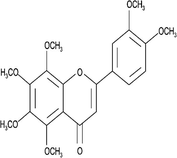
|
Citrus depressa | Suppresses ERK1/2, cyclin-D1; over-expression of p21; By decreasing the activities of mTOR and AKT. (Cell lines: MCF-7; Dose:500 ml) | (Noguchi et al., 2016) |
| Baicalin |
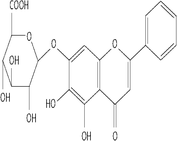
|
Scutellaria baicalensis | Decreases NF-κB-p65 protein production; NF-κB-induced raised expression of BCL2, BIRC3, BIRC2, and CCND1. (Cell lines: MCF-7 and MDA-MB-231; Dose: 0, 20 or 30 μM) | (Gao et al., 2018) |
| Ellagic acid |
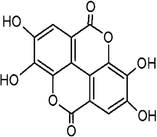
|
Juglans regia | Attenuates of signaling TGF-β/Smads (Cell lines: MCF-7 cells; Dose:0, 10, 20 and 30 μg/mL) | (Chen et al., 2015) |
| Eupatorin |
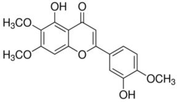
|
Eupatorium semiserratum | Increases expression of SMAC/Diablo, cytochrome c, Bax, Bak1, Bad, and HIF1A; by blocking the p-Akt pathway. (Cell lines: MCF-7 and MDA-MB-231; Dose:20 μg/ml) | (Abd Razak et al., 2019) |
| Genistein |

|
Glycine max | By down-regulating the Hedgehog-Gli1 Signaling. (Cell lines: MCF-7; Dose:10 nM–10 μM) | (Chen & Chien, 2019) |
| Increases BRCA2 and BRCA1 protein levels. (Cell lines: MCF-7, MDA-MB 231, and MCF10a; Dose:18.5 μM Genistein or 78.5 μM Daidzein) | (Bosviel et al., 2012) | |||
| Kaempferol |

|
Moringa oleifera | Stops the cell cycle in the G2/M stage by inhibiting CDK1 (Cell lines: MCF-7; Dose:10 μM) | (Akram et al., 2017) |
| Promote production of NRF2 and its NQO1 enzyme in MCF-7 cells, preventing oncogene transformation (Cell lines: MDA-MB231 cells; Dose:50 μM) | (Wang, Yang, et al., 2019) | |||
| Icariin |
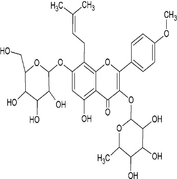
|
Epimedium sagitatum | Attenuates signaling pathway of NF-κB/SIRT6. (Cell lines: MDA-MB-231 and 4 T1; Dose:10 or 20 μM) | (Song et al., 2020) |
| Isoliquiritigenin |
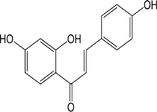
|
Spatholobus suberectus | By blocking β-catenin/ABCG2 signaling. (Cell lines: MCF-7, MDA-MB-231 and BT-549; Dose:10 μg/ml) | (Wang et al., 2014) |
| Morusin |
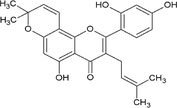
|
Ramulus mori | Through PPARγ and C/EBPβ-mediated lipo-apoptosis and adipogenic differentiation. (Cell lines: MCF-10A, 4 T1 and EMT6, MCF-7 and MDA-MB-231; Dose:1, 2, 4, 6 and 8 μg/ml) | (Li et al., 2015) |
| Myricetin |

|
Camellia sinensis | By lowering the protein production of MMP2/9 and ST6GALNAC5 expression. (Cell lines: MDA-Mb-231; Dose:50 mg/kg) | (Ci et al., 2018) |
4.3 Terpenoids for the treatment of breast cancer
Chemically terpenoid-based nutraceuticals include approximately 40,000 distinct molecules, providing an unrivaled source of chemical diversity and, as a result, a feasible supply of effective and less dangerous chemotherapeutic treatments (Ateba et al., 2018). Here we are discussing terpenoid compounds that have the potential to treat BC. A sesquiterpene derived from the Santalum album is α-santalol. The regulation of signal transductions responsible for disease progression is linked to its broad spectrum of health advantages. In numerous tumor types, the anti-tumor and cancer prevention capabilities of α-santalol have been demonstrated to include cell death promotion via apoptosis and cycle arrest. The inhibition of BC cell mobility by α-santalol could be achieved mainly by inhibiting the Wnt/β-catenin cascade (Bommareddy et al., 2018). One of the bioactive compounds in the ancient Chinese plant Astragalusmembranaceus is astragaloside IV, which possesses anticarcinogenic, immunomodulatory, cardioprotective, neuroprotective, and anti-oxidant, properties, among other things. TRHDE-antisense-RNA-1 (TRHDE-AS1) was shown to have a role in the development of BC but was triggered by astragaloside IV in BC cells, according to Shufang Hu et al. In vivo and in vitro, astragaloside IV inhibited BC cell growth and metastasis by activating TRHDE-AS1 expression (Hu et al., 2021). Betulinic acid is a lupine-structured pentacyclictriterpene that is mainly obtained from wild jujube seeds, acuminatissima leaves, and white birch bark. Betulinic acid inhibits the proliferation of BC cells by inhibiting the production of topoisomerase and cyclins, causing cell cycle arrest. It inhibits vascular endothelial growth factor (VEGF) signaling and activation of specificity protein transcription factors and NF-κB, causing apoptosis via the mitochondrial route and anti-angiogenesis. Furthermore, its downregulation of matrix metalloprotease expression has an anti-metastatic impact (Luo et al., 2016). Cucurbitacin Bis steroidal tetracyclic terpenes extracted from plants of the Cucurbitaceae family, such as cucumbers, gourds, and pumpkins. Cucurbits were utilized therapeutically by ancient civilizations. Emetics, antimalarials, and opioids were among the clinical uses. Cucurbitacin B has been shown to suppress NF-κB and signal transducer and activator of transcription 3 (STAT3), contributing to apoptotic induction (Aribi et al., 2013). Naturally sourced citral is a terpene-based aliphatic aldehyde mainly contained in essential oils extracted from citrus, ginger, and lemongrass and has antineoplastic and antiproliferative effects. Citral is a potent inhibitor of the aldehyde dehydrogenase-1A3 (ALDH1A3) enzyme, and it has been shown to suppress ALDH1A3-mediated breast tumor development via inhibiting colony formation and gene expression control (Nigjeh et al., 2018). Germacrone, a terpene derived from Rhizomacurcumae, exhibited anti-cancer potential in a human hepatoma cell line via modulating apoptosis-related proteins such as Bcl-2/Bcl-xL and Bax as well as the arrest of the cell cycle at the G2/M phase. Germacrene suppresses ERα-mediated gene expression in MCF-7 BC cells at the transcriptional level (Lim et al., 2016). A pentacyclic triterpene acid is an ursolic acid found in many vegetables and fruits, mainly extracted from Ocimumtenuiflorum. Ursolic acid inhibited cell growth via signaling pathways including epidermal growth factor receptor (EGFR), phosphatidylinositol-3-kinase (PI3K)/Akt/mammalian target of rapamycin (mTOR), and ERK (Yin et al., 2018). A sesquiterpenes β-caryophyllene oxide natural compound obtained from the essential oil of Myricarubra. Ursolic acid inhibits the growth of BC cells via caspase-3 and GSK, which PI3K/AKT regulates with the NF-κB signaling pathway (Hanušová et al., 2017). β-Elemene is a new noncytotoxic anti-cancer medication derived from the Chinese medicinal plant RhizomaZedoariae.BC metastasis was suppressed by β-elemene through limiting aerobic glycolysis driven by dimeric PKM2 conversion and nuclear transfer (Pan et al., 2019; Zhang et al., 2014). D Rhamnose β-hederin from Clematis ganpiniana is a potent triterpenoid saponin. By blocking the PI3K/AKT pathway and stimulating the ERK pathway, D Rhamnose β-hederin triggered tumor cell death (Table 3; Cheng et al., 2014).
| Compound | Chemical structure | Biological Source | Mechanism | Ref |
|---|---|---|---|---|
| α-santalol |

|
Santalum album | By inhibiting the Wnt/β-catenin cascade. (Cell lines: MDA-MB 231 and MCF-7; Dose:20, 40 μM) | (Bommareddy et al., 2018) |
| Astragaloside IV |
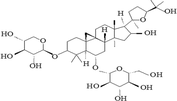
|
Astragalus membranaceus | Inhibit BC cell growth and metastasis by activating TRHDE-AS1 expression. (Cell lines: MCF-7, MDA-MB-231, and MDA-MB-468; Dose:40 and 80 μg/ml) | (Hu et al., 2021) |
| Betulinic acid |

|
Castanopsis acuminatissima | By Decreasing topoisomerase and cyclin; VEGF signaling inhibition; Reducing SP and NF-κB activation; downregulation of matrix metalloproteases expression. (Cell lines: MCF-7; Dose:50 μM) | (Luo et al., 2016) |
| Cucurbitacin B |

|
Cucurbeta pepo | Suppress NF-κB and STAT3. (Cell lines: MDA-MB-231; Dose:0.5 and 1 mg/kg) | (Aribi et al., 2013) |
| Citral |

|
Cymbopogon citratus | Down regulating aldehyde-dehydrogenase-1A3 expression. (Cell lines: MDA-MB-231; Dose:2.5, 5.0 and 10.0 μg/ml) | (Nigjeh et al., 2018) |
| Germacrone |

|
Rhizoma curcumae | By suppresseing ERα-mediated gene expression. (Cell lines: MCF-7; Dose:100 or 200 μM) | (Lim et al., 2016) |
| Ursolic acid |

|
Ocimum tenuiflorum | Downregulation of EGFR, PI3K/Akt/mTOR, and ERK. (Cell lines: MDA-MB-231; Dose:10.0 μg/ml) | (Yin et al., 2018) |
| β-caryophyllene oxide |

|
Myrica rubra | Suppression of NF-κB. (Cell lines: MDA-MB-231 and MCF7; Dose:5–500 μM) | (Hanušová et al., 2017) |
| β-Elemene |

|
Rhizoma Zedoariae | limiting aerobic glycolysis driven by dimeric PKM2 conversion and nuclear transfer. (Cell lines: MDA-MB-231 and MCF-7; Dose:0–320 μmol/L) | (Pan et al., 2019) |
| D Rhamnose β-hederin |

|
Clematis ganpiniana | By blocking the PI3K/AKT pathway and stimulating the ERK pathway. (Cell lines: MCF-7, MDA-MB-231, BT474, SUM1315; Dose: 5, 10, 20, 40 and 80 μg/ml) | (Cheng et al., 2014) |
4.4 Alkaloids for the treatment of breast cancer
Alkaloids are essential natural compounds that can be used to develop new drugs. In vitro and in vivo, some alkaloids derived from natural herbs have anti-proliferative and antimetastasis properties against various malignancies. We are talking about some alkaloid chemicals that may be used to treat BC. A biscoclaurine alkaloid, Cepharanthine, derived from Stephaniacepharantha, has been demonstrated to have anti-tumor properties in several malignancies. CEP inhibited the proliferation and motility of MCF-7 and MDA-MB-231 BC cells and triggered autophagy and death via disrupting AKT/mTOR signaling system (Gao et al., 2017). Colchicine, the active ingredient in Colchicum autumnale, is a natural tubulin modulator with anti-tumor properties. Colchicine's inhibitory and apoptosis-inducing properties in BC cells were linked to mitosis disruption, resulting in cells stuck in the G2/M phase (Sun et al., 2016). The alkaloid dehydrocorydaline, isolated from Corydalisyanhusuo, has anti-cancer properties. DHC inhibited tumor cell antiapoptosis, growth, and metastasis-related proteins BCL 2, CCND 1, BCL 3, and CDK1, as well as MMP9 and MMP2, which are related to metastasis, as well as modulating the production of proapoptotic proteins caspase9/3/8 (Huang et al., 2020). Harmine is a β-carboline alkaloid that was first discovered in Peganumharmala seeds. In vitro, harmine decreased tumor development by suppressing cellular growth and migration, promoting tumor cell death, and inhibiting tumor development in vivo. pErk, Bcl2, pAkt, and Transcriptional-co-activator-with-PDZ-binding motif (TAZ) expression were also considerably reduced by Harmine (Ding et al., 2019). Lycorine is an alkaloid found in the Amaryllidaceae family of plants. Lycorine is a compound that alleviates chronic inflammation, viral infections, malarial infections, and cell division inhibition. Lycorine decreased tumor cell motility and infiltration by disrupting the Src/FAK (focal adhesion kinase) pathway (Ying et al., 2017). Matrine is an active chemical discovered in Sophoraflavescens, an ancient China medicinal plant. It has various pharmacological activities, including antiviral, anti-cancer, anti-inflammatory, and antifibrotic activity. Matrine triggered autophagy in MCF7 cells, demonstrating light chain 3 II accumulation and p62 decreased expression. Matrine also inhibited the phosphorylation of mTOR and AKT (Du et al., 2020). Opium-derived Noscapine is a phthalideisoquinoline alkaloid that is being employed as an antitussive. Noscapine-induced expression decreased the expression of anti-apoptotic genes and proteins while increasing the expression of proapoptotic genes and proteins, most likely due to a reduction in the expression of NF-κB gene and protein in IκBα gene expression produced by noscapine (Quisbert-Valenzuela & Calaf, 2016). Tanshinone-IIA is a critical active ingredient derived from Salvia miltiorrhiza (Danshen), extensively utilized in Chinese medicine with antiangiogenic, antiplatelet aggregation, anti-inflammatory, and anti-inflammatory, anti-cancer properties. In vitro and in vivo, Tanshinone-IIA may efficiently cause S-phase stoppage and significantly inhibit MDA-MB-231 cell motility and infiltration. Tanshinone-IIA activates ROS, which leads to the decrease of FAK, which promotes the increase of GSK3β expression that inhibits the activation of MMPs, preventing tumor cell metastasis (Wu et al., 2018). Piperlongumine is an alkaloid found in the root of the Piper longum plant. It has various biological effects, including antidepressant, anti-nociceptive, and antifungal activities. In human triple-negative BC cells, piperlongumine lowered Bcl-2, cyclin D1, p-Akt, p53, p70S6K1, and 4E-BP1 expression while enhancing cytochrome c and Bax expression (Shrivastava et al., 2014). Theobromagrandiflorum contains the purine alkaloid theacrine, which has antioxidant, sedative/hypnotic, locomotor, and anti-inflammatory activities. In cells, theacrine can reverse EMT, resulting in a reduction in mesenchymal biomarkers (Vimentin, Snail, Twist, N-cadherin, and Fibronectin) and a surge in epithelial biomarkers (E-cadherin and Occludin). In MDAMB231 cells, theacrine also inhibits TGFβ-induced EMT cell attachment, motility, and penetration (Ko et al., 2019; Table 4).
| Compound | Chemical Structure | Biological Source | Mechanism | Ref |
|---|---|---|---|---|
| Cepharanthine |

|
Stephania cepharantha | By disrupting AKT/mTOR signaling system. (Cell lines: MDA-MB-231 and MCF-7; Dose: 5 μM for MCF-7, 4 μM for MDA-MB-231) | (Gao et al., 2017) |
| Colchicine |

|
Colchicum autumnale | By cells stuck in the G2/M phase. (Cell lines: MCF-7 cells; Dose: 0.3125, 0.625, 1.25, 2.5, 5, 10, 20 and 40 μg/ml) | (Sun et al., 2016) |
| Dehydrocorydaline |

|
Corydali syanhusuo | By decreasing BCL 2, CCND 1, BCL 3 and CDK1 as well as MMP9 and MMP2 and increasing formation of pro-apoptotic proteins caspase9/3/8. (Cell lines: MDA-MB-231; Dose: 20, 30, 40, 50 or 100 μM) | (Huang et al., 2020) |
| Harmine |

|
Peganum harmala | Via reduction in expression of pErk, Bcl2, pAkt, and TAZ. (Cell lines: MDA-MB-231 and MCF-7; Dose: 50, 100 or 150 μM) | (Ding et al., 2019) |
| Lycorine |

|
Narcissus pseudonarcissus | By disrupting the Src/FAK pathway. (Cell lines: MCF-7, T47D, MDA-MB-231; Dose: 5 or 10 mg/kg) | (Ying et al., 2017) |
| Matrine |

|
Sophora flavescens | By light chain 3 II accumulation and p62 decreased expression; inhibited the phosphorylation of mTOR and AKT. (Cell lines: MCF-7; Dose: 2, 4, 8 and 10 mM) | (Du et al., 2020) |
| Noscapine |

|
Papaver somniferum | Reduction in expression of NF-κB gene and protein as well as a rise in IκBα gene expression. (Cell lines: MCF-10F, MCF-7, MDA-MB-231; Dose: 20, 40, 60, 80 and 100 μM) | (Quisbert-Valenzuela & Calaf, 2016) |
| Tanshinone-IIA |
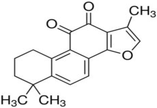
|
Salvia miltiorrhiza | By causing S-phase stoppage of cell cycle, increasing of GSK3β expression, inhibiting the activation of MMPs. (Cell lines: MDA-MB-231 cells; Dose: 0, 3 and 6 μM) | (Wu et al., 2018) |
| Piperlongumine |

|
Piper longum | By lowering Bcl-2, cyclin D1, p-Akt, p53, p70S6K1 and 4E-BP1 expression and enhance cytochrome c and Bax expression; By inhibiting signaling axis of PI3K/Akt/mTOR. (Cell lines: MCF-7 (ER + ve), MDA-MB-231(ER -ve), MDA-MB-453 (HER -ve) and BT-549 (ER -ve); Dose: 6.25, 12.5, 25, 50 and 100 lM) | (Shrivastava et al., 2014) |
| Theacrine |

|
Theobroma grandiflorum | Inhibits TGFβ-induced EMT. (Cell lines: MDA-MB-231; Dose: 10–100 μM) | (Ko et al., 2019) |
5 CONCLUSION AND FUTURE PERSPECTIVE
Nutraceuticals' importance and contribution to the control and diagnosis of breast cancer are undeniable and cannot be overlooked. Natural dietary compounds have a wide range of uses and have been used in ancient medicine for an extended period. However, more focus should be placed on research to improve the action of these chemicals and promote them as a therapy for breast cancer patients. Upon receiving a cancer diagnosis, many individuals seek out nutraceuticals in the belief that they can provide nutritional alleviation. Certain herbal supplements may hinder or alter the metabolism of prescription drugs. Some natural compounds may be useful for chemoprevention on their own or in combination with a healthy diet. The first stages of carcinogenesis, cancer spread, and metastasis have been inhibited by these natural agents, at least in the laboratory; nevertheless, further study is required in this field. Incorporating prooxidant-active nutraceuticals into the diet, which may have the opposite effect, may also contribute to cancer prevention by diminishing the efficacy of chemotherapy. This is one of the reasons why persons receiving chemotherapy should weigh the merits and drawbacks of supplementation. These natural chemicals can enhance the effectiveness of other traditional medicines. They may also be employed as a treatment process independently because of their capacity to affect several pathways. This study highlights a variety of natural chemicals, and their mechanisms of action, routes, synergistic effects, and future potentials are all examined. As a result, an additional in-depth study is needed to validate the proper role of these compounds, which will help us identify their clinical applications and combat the current issues of breast cancer.
AUTHOR CONTRIBUTIONS
Khalid Saad Alharbi: Conceptualization; Methodology. Waleed Hassan Almalki: Formal analysis; Methodology. Hafiz A. Makeen: Investigation; Software. Mohammed Albratty: Validation; Methodology; Formal analysis. Abdulkarim M. Meraya: Writing—original draft; Visualization; Project administration. Rupak Nagraik: Investigation; Data curation. Avinash Sharma: Investigation; Writing—original draft. Deepak Kumar: Writing—original draft; Software. Dinesh Kumar Chellappan: Visualization; Data curation. Sachin Kumar Singh: Writing—review & editing; Formal analysis. Kamal Dua: Writing—review & editing; Supervision. Gaurav Gupta: Supervision; Resources.
Funding information
The authors extend their appreciation to the Deputyship for Research & lnnovation, Ministry of Education in Saudi Arabia for funding this research work through the project number “20-UQU-IF-P1-001”. The project was funded by Deanship of Scientific Research at Umm Al-Qura University for the supporting this work by Grant Code (Project Code: 22UQU4310387DSR19).
ACKNOWLEDGMENTS
All authors are thankful to University of Technology Sydney. Open access funding provided by CAUL.
CONFLICT OF INTEREST
The authors declare no conflict of interest.
ETHICS APPROVAL
Not applicable.
CONSENT TO PARTICIPATE
Not applicable.
CONSENT FOR PUBLICATION
Not applicable.
Open Research
DATA AVAILABILITY STATEMENT
Data sharing is not applicable to this article as no new data were created or analyzed in this study.




